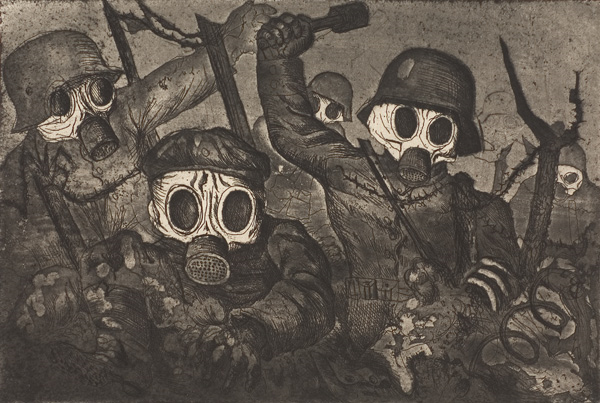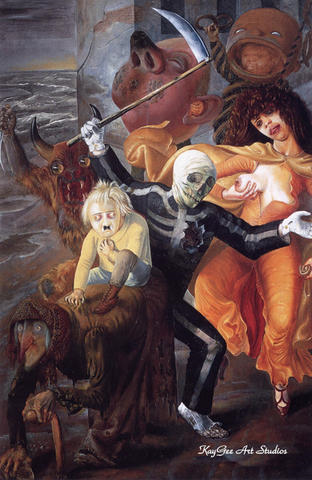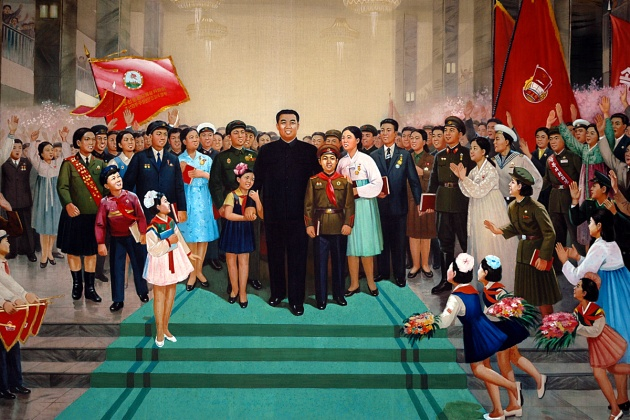Art has a long history of being involved in the achievement of political goals; consider the monumental imperial advertisement of power and control of resources represented by the huge Colossus of Rome[1]. In the early 20th century, what was termed realism was not the direction that popular art movements were taking.
However, what was termed realism seemed to serve the aims of totalitarian movements at the time, despite the fact that no art is truly realistic and all art represents a set of choices from all the visual detail available.
Nevertheless, the objections of the Nazi regime to all the non-realist artists is understandable in light of the Third Reich’s goals and methods of achieving them. They were trying to influence people to do things that were difficult and morally ambiguous, if not downright horrible.
To accomplish this, they needed powerfully effective images that everyone could understand without laborious or inconvenient verbal explanation. The artists that the Nazi regime disapproved of had the opposite aim in creating art.
They were seeking to create art that was a vehicle for personal expression. Given this attitude, it is no wonder that non-realistic artists were suppressed. Useful examples of these two divergent approaches are found in the art of Fritz Erler and Otto Dix.
The term ‘realism’ has meant different things over time. It meant something different in the 1800s than what it suggests today.
Before the early 1800s, most painting tried consciously to show everything in as beautiful, serene, classically pure a fashion as posssible, even if this meant deliberately changing things around in the picture, as, for example, advised by an accepted authority of the time, Roger de Piles.
Starting with the Romantic movement in art, there was a gradual reaction away from a classical idealization of the subject, whether a person, a scene, or a landscape.
The gritty reality of the world became more acceptable and desirable in art. An example is the often gory work of Théodore Géricault, a proponent of Romanticism, such as his Raft of the Medusa. This work, and by extension, much of the effort of the Romantic movement, was described as an,” extended, no-holds-barred quest for truthfulness and intensity”.
However, up until the period of the Impressionists in the mid to late 1800s, there was a generally shared goal of depicting the world as most people could recognize it. For example, a person had two eyes symmetrically laid out, sky was more or less blue, and trees were more or less green.
With Impressionism, Cubism, and their successor art movements, this all changed, dramatically. The depiction of objects in the real world was no longer safely to be assumed. Buchloh describes this process of movement away from figurative art as follows:
“the perceptual conventions of mimetic representation – the visual and spatial orderign systems that had defined pictorial production since the Renaissance… systematically broken down since the middle of the nineteenth centry”.
Buchloh is drawing attention to a phenomenon that even non-artists can observe. It seems reasonable to assert that all art imposes a warping of physical reality to some extent. Simply by trying to depict a three dimensional world on a two dimensional surface, there is inevitable distortion.
The tree is not the picture, nor vice versa. It cannot be. The simplest tricks of perspective, such as foreshortening, or narrowing two parallel lines down to a vanishing point, demonstrate this. In any work of art, a process of transformation has taken place as the scene or object is translated by the artist onto paper or canvas or marble.
A recent news story humorously and clearly demonstrated this: A quirky installation artist in Philadelphia, who apparently regularly enrobes local landmarks with knitted textile art, tried to measure the famous statue of Rocky Balboa for a sweater.
She discovered the that the proportions of the eight foot tall statue were wildly different from those of an actual real person’s. However, photos of this statue do not strike the viewer as bizarre. The artist clearly altered the real proportions of the subject in a way that looks normal from a distance.
Thus, even in representing a real-world subject with the aim of fidelity, the process involves the abstraction, or pulling out, or alteration of certain elements and the de-emphasizing of others.
This may be used to indicate, for example, that the subject is a distance away, or to allow the viewer to distinguish the subject from its background. This is a matter of making sure that the viewer can see the forest for the (edited) trees.
Thus, when anyone is uses the term realism in art today, they are speaking relatively. A formal definition of realism describes it as,”Fidelity to nature or to real life; representation without idealization, and making no appeal to the imagination; adherence to the actual fact.”
It requires some visual training to understand any two-dimensional representation, as students learn in History of Art classes. It is relatively easier for someone trained by experience at decoding two-dimensional representations to recognize a realistically painted subject.
Nonetheless, when we use the term realism today, implying that the subject of the work of art is able to be recognized for what is intended, we understand what is meant. This term is probably widely and intuitively understood in our era.
The Nazi regime, like many other oppressive governments, sought to use all available tools to alter people’s opinions, direct their behavior, or change the entire form of government. Art was just one of these.
Their goals were often violent and involved hurting other people, such as Jews, gypsies, and the crippled. These folks had often been neighbors and colleagues.
This is a course of action that could inspire ambivalent feelings about cooperating, in many people. The ugliness of the Nazi’s goals, and the negative reaction of the rest of the world, like made it desirable to communicate their intention as much as possible without words.
If the Nazis had said in plain terms that they were going to kill with poison gas millions of harnless people, it would have sounded harsh.
But if the Nazis could make the German people feel that they were threatened and that the threat should be removed in whatever way was most effective, the government could get better cooperation. This threat, as we now know, was blamed on non-German elements in society, especially the Jewish population.
As it happened, the rise of the Third Reich coincided with the development of a new concept in the new sciences of psychology and psychiatry. The idea of archetypal images was pioneered by Carl G. Jung. Jung suggested that the human mind shares a collective unconscious.
This collective unconscious contains within it patterns that reliably generate images, or archetypes everyone can recognize. This, Jung asserts, is true over time and across the globe. He suggested that an example of the expression of archetypal images can be found in many myths, for example the myth of the Hero.
Clearly this is a great convenience for a regime that hopes to affect the population’s ideas and attitudes without actually coming out and saying what they want. Jung himself believed that the trends in Germany leading up to the war were an expression of archetypes that had been repressed.
While evidence for specific use of Jung’s ideas in creating Nazi art is not readily available, it is interesting that Jung and a relative of one of Hitler’s close advisors, Goring, shared the editorship of a psychiatric journal. This suggestst that the Hitler regime was well aware of Jung’s work and ideas.
If the Hitler regime was using archetypes, or even telling a story, they needed for viewers to recognize the message. This is more difficult to accomplish in non-realistic form. This is because the messages that the Nazis were attempting to propogate had to do with human issues and concerns, such as motherhood, or attachment to a place, or pride in one’s heritage, for example.
At the time, artists – those who were innovating and at the cutting edge of their field – were not oriented towards telling stories or sending explicit or implicit messages. They were not oriented towards, “the direct creation of universal beauty”, but instead, “ the aesthetic expression of oneself”, as Mondrian put it.
The movement away from the subject entirely was seen, as expressed by Mondrian, as an evolution of art, and highly desirable Mondrian says that, “by its existence non-figurative art shows that ‘art’ continues always on its true road. It shows that ‘art’ is not the expression of the appearance of reality…nor of the life that we live…”.
This process of making art something that needed only to please and express the artist’s own feelings, can and did result in art that was and is less accessible to many viewers. Buchloh asserts that this inaccessibility was an irritant. He asserts that there was pressure at the time from viewers (the public) against the abstractions that had dominated the art world.
Discussing the swing back to figurative art after the first World War, he says, “And how did this shift come to be understood as an autonomous achievement of the masters, who were in fact the servants of an audience craving for the restoration of the visual codes of recognizability, for the restoration of figuration?”
The leading lights of the art world were not sympathetic, to these consumer longings, if the views of Mondrian are typical. Mondrian, in defending non-realistic art, criticized those who had made, “no effort to know pure abstract art”. These people, he asserted, were against the, “progress of the elite”.
The implication of this attitude on the part of the artist is that it requires specific and rather sophisticated training on the part of the viewer to appreciate the pure abstract art. Mondrian’s atttitude implies that if a viewer is not willing or able to invest this effort, then their opinion is not worthwhile.
Thus, the viewing public that shook their heads in puzzlement at abstract art were dismissed. All these attitudes are very self-centered, and not at all in tune with nationalistic self-sacrifice.
Unfortunately for artists with this seemingly self-centered approach and obliviousness to whether or not the art was being understood, the Nazis, like the Russian revolutionaries, explicitly wanted art that supported their goals, a “heroic realism”. They were concerned about a national elite rather than a class elite.
In Hitler’s words, “For the artist does not create for the artist, but like everyone else, he creates for the people.” Hitler explicitly referred to this isssue of comprehensiblity in the following statement of intention:
‘Works of art’ which cannot be understood in themselves but for the justification of their existence, need those bombastic instrucitons for their use, finally reachign that intimidated soul, who is patiently willing to accept such stupid or impertinent nonsense – these works of art from now on will no longer find their way to the German people.”
The Hitler regime went to extremes in implementing his extreme intention. To see how these conflicting ideas of art for the artist’s sake, and art for the good of the regime played out, it is useful to examine two artists who addressed similar subject matter. They were, however, far differently regarded and treated by the Third Reich.
Both were actvie in and after the first World War. Both artists included war and battlefied subjects in their works. Both were, in retrospective, competent technically. Fortunately, works by both of them survive. It is interesting that two pictures of the same subject, created within seven years of one another, should be looked at so differently by the Third Reich.
Fritz Erler (1868-1940), who (although he did distort reality) depicted soldiers as heroes, was approved of by the regime. Otto Dix (1891-1969), who distorted figures to look like monsters, but depicted soldiers as well, was not approved of. They were both technically very competent.
Erler produced a number of war bonds posters for the first World War. One, entitled Helft Uns Siegen, shows an idealized soldier gazing into the indeterminate distance with eyes that glow internally. He is a strapping, well-fed, heroic fellow, with his gas mask down around his neck, alertly at ease after the attack.
He appears fully human, despite those wierdly glowing eyes, oddly elevated mood, and unseen visual point of focus. He is a fellow you would happily share a meal with or for whose benefit you would happily buy a war bond, if you were a loyal German.
Although this picture dates from 1917, Erler had a continuing career. Erler was highly thought of by the Hitler regime. This is attested to by the fact that he was rewarded for his complimentary perspective on the German soldier with at least one commission for a portrait of Hitler. This was a signal honor for any artist or photographer in Germany.
The most famous surviving such piece painted by Erler is probably his Portrait of The Leader. This shows Hitler as the genius and sponsor of art and architecture. The Kunsthalle, Hitler’s most ambitious architectural design that was implemented, is shown in the background. Hitler appears before a heroic statue of a mounted horseman.
It is useful to compare Erler’s work to that of another favorite of the Third Reich’s, Arno Breker. Whereas Erler’s soldier did not look classically beautiful, and in fact has features which are somewhat coarse, Breker seemed to consciously hearken back to Roman and Greek models.
This must have flattered the regime with references to an earlier, very powerful empire. Arno Breker created sculptures of naked men that were heroic in size, and in mood.
They were chisel-faced, with clearly defined muscles and extreme poses. In spite of his close relationship with Hitler’s government, he worked to help artists who were out of favor, indicating that the political beliefs and artistic production were not inextricably linked.
Looking at an artist who was decidedly not in the good graces of the Third Reich, we see a very different approach from either Erler or Breker. Otto Dix, who served in the German army in World War I, was another artist who portrayed soldiers in the action of war-time. He produced a terrifying etching of soldiers wearing gas-masks.
It is entitled Stormtroops Advancing Under Gas. The soldiers look like imps or goblins, or at best, children in Halloween masks. They weapons make a diagonal cross-hatch in the composition, with their bayonets pointing in one direction, and some sort of blunt instrument and fists pointing in the other direction.
They have no grace, and seem to waddle or stumble in the midst of the confusion and terror of battle. Their forms and proportiions are distorted and they are almost cartoonlike. They appear less than human, and unrecognizable as one’s neighbors or son.
When one compares the sturdy and heroic soldier in Erler’s work, and the cartoon-like figures in Dix’s work, it is easy to see why the German government objected to being portrayed that way. Hitler did not want soldiers depicted as space aliens or evil dwarves.
He wanted handsome heroes, preferably looking like the heroes of ancient Greece and Rome. Dix was certainly not showing that – he was showing what it felt like to be on there on the battlefield with stormtroops and mustard gas.
Both artists actually distorted reality, but Dix did it in such a way as to insult the soldiers, while Erler did it in such a fashion as to make them look inspired.
They were both drawing on archetypal images, but Erler’s was evoking the hero, like Theseus after slaying the Minotaur, while the other (Dix) was evoking something more like the Furies descending on a hapless mortal, in the form of stormtroops.
Given the aims of the Nazi regime, it is entirely comprehensible that one should have been rewarded and the other discredited. Clearly, the approach that Erler takes to the subject of the German soldier is more complimentary.
Dix, on the other hand, is obviously critical in his attitude towards war, and its methods. He was also openly critical of the major players in the Third Reich. A painting of his entitled The Seven Deadly Sins actually caricatures Hitler as a baby (mustacheless) demon. He painted this after he was discharged from the art academy in Dresden.
In our own lifetime, the governments of both South and North Korea have used images to control thinking and behavior. This is an interesting phenomenon in light of the overt attempts by previous totalitarian regimes to harness art for their own aims. It is also interesting in light of the power that popular media has today, even in supposedly free societies.
Art has been a tool of governments since the earliest times. Until the middle of the 1800s, there was a shared expectation that art would represent things in the physical world as they appeared to most of the viewing public. The term realism, however, referred to different things before then.
No matter whether the approach is Neo-classical, grittily Romantic, oddly Mannerist, or Impressionist, all art distorts the physical truth of its subject matter. There is unavoidably a choice of what to include and what not to include. Thus, when governmental regimes that say they want realism are actually saying that they want the prerogative to choose which distortions they permit.
Fritz Erler’s particular distortions, which contributed to a heroic image of the German soldier, served the Nazi purposes. His representation was less beautiful than that of Arno Breker, a sculptor of very different style who also found favor with the Nazis. On the other hand, Otto Dix’s idiosyncratic distortions, which made the German soldier look like a troll, was decidely not what the Nazis were looking for in their public messages.
Given that the regime wanted art for propaganda, and self-praise, it is easy to see why they preffered Erler’s sturdy heroes to Dix’s goblins.[2] They wanted the German people to identify with healthy and strong images rather than with ugly representations of themselves.
Such use of art to control opinion is still used today in regimes such as the North Korean’s. We need to be cautious, still, even in democracies, that we do not allow art to become the uncontrolled tool of government propaganda.






Bibliography
Art in the Picture. “Otto Dix.” Art in the picture. 2011. Web.
Asssociation of Artists of Revolutionary Russia. “AKhRR Declaration.” In Art In Theory: 1900-2000, by Charles Harrison and Peter Wood, 403-406. Oxford: Wiley-Blackwell, 2002.
Brainyquote.com. Realism. 2011. Web.
Breker, Arno. Torchbearer. Unknown.
Breker, Arno. Torchbearer. Great Triumphal Art, Berlin.
Buchloh, Benjamin D. “Figures of Authority, Ciphers of Regression: Notes on the Return of Representation in European Painting.” In Art in Modern Culture: an Anthology of Critical Texts, by Francis Frascina and Jonathan Harris, edited by Francis Frascina and Jonathan Harris, 222-238. London: Phaedon Press, 1992.
Crimmins, Peter. Gritty in Pink. 2011. Web.
de Piles, Roger. The Principles of Painting. Vol. 2, in A Documentary History of Art: Michelangelo, the Mannerists, the Baroque, and the Eighteenth Century, edited by Elizabeth Gilmore Holt, 176-187. Garden City, NJ: Doubleday and Company, Inc., 1958.
Dix, Otto. Stormtroops Advancing Under Gas. National Gallery Of Australia, Canberra.
Dix, Otto. The Seven Deadly Sins. Staatliche Kunsthalle, Karlsruhe.
Dobrzynski, Judith H. “Sex Blood and War from Wiemar Anti-Nazi Otto Dix.” Antifascistencyclopedia.com. 2011. Web.
Erler, Fritz. “Helft Uns Siegen.” Imperial War Museum. Web.
Erler, Fritz. “Portrait Of The Leader.” Unknown. 1938. Web.
Florida Center for Instructional Technology. Nazi Approved Art: A Teacher’s Guide to the Holocaust. 2005. Web.
Géricault, Théodore. The Raft of the Medusa. Musée du Louvre, Paris.
German Propoganda Archive. Hitler in Nazi Art. 2011. Web.
Griffin, Roger. “Nazi Art: Romantic Twilight or Post-modernist Dawn?” Oxford Art Journal, vol. 18, no. 2. 1995.
Hitler, Adolf. “Speech Inaugurating the Great Exhibition of German Art.” In Art in Theory: 1900-2000, by Charles Harrison and Peter Wood, 439. Oxford: Wiley-Blackwell, 2002.
Jung, Carl Gustav. “On the Concept of the ‘Archetype’.” In Art in Theory: 1900-2000, by Charles Harrison and Peter Wood, 378-381. Oxford: Wiley-Blackwell, 2002.
Lankov, Andrei. The Official Propaganda in the DPRK: Ideas and Methods. 1995. Web.
Lenin, Vladimir Ilyich. “On Proletarian Culture.” In Art in Theory: 1900-2000, by Charles Harrison and Peter Wood, 402. Oxford: Wiley-Blackwell, 2002.
Medweth, Mark. “Jung and the Nazis.” Personality and Consciousness. 1996. Web.
Mondrian, Piet. “Plastic Art and Pure Plastic Art.” In Art in Theory: 1900 – 2000, by Charles Harrison and Peter Wood, 387-393. Oxford: Wiley-Blackwell, 2002.
Newsweek. “North Korean Propaganda Art.” Newsweek, 2010.
Platner, Samuel Ball. “Colossus Neronis.” In A Topographical Dictionary of Ancient Rome, by Samuel Ball Platner, 130-131. London: Oxford University Press, 1929.
Prometheseus. “Arno Breker Biography.” Prometheseus. 2002. Web.
Wilkin, Karen. “Romanticism at the Met.” The New Criterion 22, no. 4 (2003): 37-42.
Footnotes
- Such a piece had no function other than overwhelming the viewer with how strong the emperor must have been to have created such an object. The Colossus was a bronze statue 120 feet high, and the Emperor Nero had it erected solely to honor himself and make himself seem more impressive. Subsequent emperors modified it to suit their own purposes, changing the face, and adding rays around the head, for example. The gigantic sculpture gave its name to the Coliseum.Samuel Ball Platner (as completed and revised by Thomas Ashby). “Colossus Neronis”. A Topographical Dictionary of Ancient Rome. (London, Oxford University Press 1929). Page 130A Topographical Dictionary of Ancient Rome, London: Oxford University Press, 1929.
- This sort of preference is expressed in modern North Korea, as noted in the following description:“On the whole, paternalist ideas about “the ruler – father of the nation”, typical of the Confucian philosophical tradition, are the norm in North Korean propaganda. In propaganda stories one can find in North Korean magazines and school textbooks, Kim Il Song depicted as a fatherly figure, a wise and attentive parent caring for his people. In one story, he stops his limo to give a lift to an old woman, in another he personally oversees how a medical help is delivered to a young worker hurt in a factory incident, and in a third he inquires about the living conditions of a handicapped veteran. These stories about the Kims number in the many hundreds, and are constantly repeated in the media and textbooks, read aloud at meetings, or portrayed in paintings. Some of these stories are not simply Confucian in spirit, but are often remakes of popularstories from the Confucian mythology.” (Lankov 1995) A graphic example is found with the other pictures.